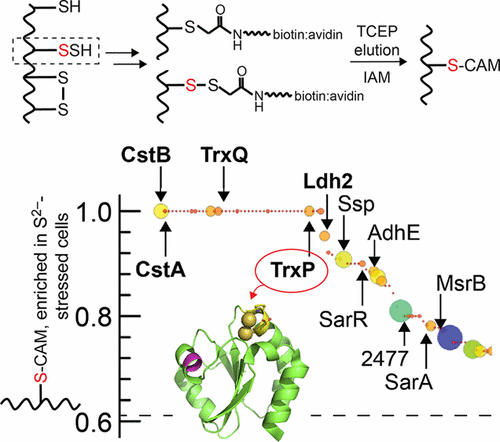当前位置:
X-MOL 学术
›
ACS Infect. Dis.
›
论文详情
Our official English website, www.x-mol.net, welcomes your feedback! (Note: you will need to create a separate account there.)
Hydrogen Sulfide and Reactive Sulfur Species Impact Proteome S-Sulfhydration and Global Virulence Regulation in Staphylococcus aureus
ACS Infectious Diseases ( IF 5.3 ) Pub Date : 2017-09-06 00:00:00 , DOI: 10.1021/acsinfecdis.7b00090 Hui Peng 1, 2 , Yixiang Zhang 1, 3 , Lauren D. Palmer 4 , Thomas E. Kehl-Fie 5 , Eric P. Skaar 4 , Jonathan C. Trinidad 1, 3 , David P. Giedroc 1, 6
ACS Infectious Diseases ( IF 5.3 ) Pub Date : 2017-09-06 00:00:00 , DOI: 10.1021/acsinfecdis.7b00090 Hui Peng 1, 2 , Yixiang Zhang 1, 3 , Lauren D. Palmer 4 , Thomas E. Kehl-Fie 5 , Eric P. Skaar 4 , Jonathan C. Trinidad 1, 3 , David P. Giedroc 1, 6
Affiliation

|
Hydrogen sulfide (H2S) is thought to protect bacteria from oxidative stress, but a comprehensive understanding of its function in bacteria is largely unexplored. In this study, we show that the human pathogen Staphylococcus aureus (S. aureus) harbors significant effector molecules of H2S signaling, reactive sulfur species (RSS), as low molecular weight persulfides of bacillithiol, coenzyme A, and cysteine, and significant inorganic polysulfide species. We find that proteome S-sulfhydration, a post-translational modification (PTM) in H2S signaling, is widespread in S. aureus. RSS levels modulate the expression of secreted virulence factors and the cytotoxicity of the secretome, consistent with an S-sulfhydration-dependent inhibition of DNA binding by MgrA, a global virulence regulator. Two previously uncharacterized thioredoxin-like proteins, denoted TrxP and TrxQ, are S-sulfhydrated in sulfide-stressed cells and are capable of reducing protein hydrodisulfides, suggesting that this PTM is potentially regulatory in S. aureus. In conclusion, our results reveal that S. aureus harbors a pool of proteome- and metabolite-derived RSS capable of impacting protein activities and gene regulation and that H2S signaling can be sensed by global regulators to affect the expression of virulence factors.
中文翻译:

硫化氢和反应性硫物种影响蛋白质组S-硫酸化和金黄色葡萄球菌的整体毒力调节。
硫化氢(H 2 S)被认为可以保护细菌免受氧化应激的影响,但对其在细菌中的功能的全面了解尚待探索。在这项研究中,我们表明人类病原体金黄色葡萄球菌(S. aureus)具有H 2 S信号,反应性硫物种(RSS)的重要效应分子,如低分子量的硫代硫醇,辅酶A和半胱氨酸,以及显着的无机多硫化物种类。我们发现蛋白质组S硫水化,在H 2 S信号转导中的翻译后修饰(PTM),在金黄色葡萄球菌中很普遍。。RSS水平调节分泌的毒力因子的表达和分泌物组的细胞毒性,这与全球毒力调节剂MgrA对S的硫酸化依赖性DNA结合的抑制作用相一致。在硫化物胁迫的细胞中,两个先前未被表征的硫氧还蛋白样蛋白被称为TrxP和TrxQ,它们被S硫酸化,并能够还原蛋白二硫化氢,表明该PTM在金黄色葡萄球菌中具有潜在的调控作用。总之,我们的结果表明,金黄色葡萄球菌具有蛋白质组和代谢物衍生的RSS,能够影响蛋白质活性和基因调控,并且H 2S信号可以被全局调节剂感知以影响毒力因子的表达。
更新日期:2017-09-06
中文翻译:

硫化氢和反应性硫物种影响蛋白质组S-硫酸化和金黄色葡萄球菌的整体毒力调节。
硫化氢(H 2 S)被认为可以保护细菌免受氧化应激的影响,但对其在细菌中的功能的全面了解尚待探索。在这项研究中,我们表明人类病原体金黄色葡萄球菌(S. aureus)具有H 2 S信号,反应性硫物种(RSS)的重要效应分子,如低分子量的硫代硫醇,辅酶A和半胱氨酸,以及显着的无机多硫化物种类。我们发现蛋白质组S硫水化,在H 2 S信号转导中的翻译后修饰(PTM),在金黄色葡萄球菌中很普遍。。RSS水平调节分泌的毒力因子的表达和分泌物组的细胞毒性,这与全球毒力调节剂MgrA对S的硫酸化依赖性DNA结合的抑制作用相一致。在硫化物胁迫的细胞中,两个先前未被表征的硫氧还蛋白样蛋白被称为TrxP和TrxQ,它们被S硫酸化,并能够还原蛋白二硫化氢,表明该PTM在金黄色葡萄球菌中具有潜在的调控作用。总之,我们的结果表明,金黄色葡萄球菌具有蛋白质组和代谢物衍生的RSS,能够影响蛋白质活性和基因调控,并且H 2S信号可以被全局调节剂感知以影响毒力因子的表达。



























 京公网安备 11010802027423号
京公网安备 11010802027423号